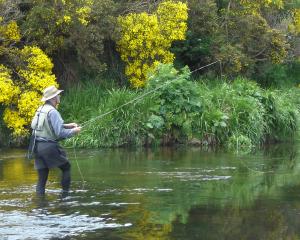Anglers know only too well how the weather can affect our sport.
It can affect us on the day we go fishing — we either swelter or freeze but strangely it is rarely just right.
The days before an outing on the river can be just as critical, especially in terms of rainfall and temperature — too much rain and the outing may be abandoned due to high and discoloured rivers and smaller streams may become too warm for trout to feed or even survive.
Knowing what the weather is likely to be like as well as the prevailing river conditions is essential for the planning of a successful outing.
Perfect conditions are river levels falling or stable at a medium to low flow with the temperature in the mid-teens and the water clear.
The ideal weather is a well-established high-pressure system which usually manifests itself in the form of fine warm weather with light winds.
The places that are looking good this weekend are the Mataura, the middle and lower Taieri and the Pomahaka and if it is warm enough, the tussock lakes.
In the rivers trout will be feeding on willow grub where there are willows and there will be a fall of spinners on calm mornings on mayfly waters and sedges just about everywhere in the evenings.
On the lakes there will be beetles, water boatmen and damsel flies for trout to eat.
My recent fishing gives examples of the vagaries of weather and fish.
Last weekend I fished the Mataura in the middle of a high-pressure system. It was hot and sunny all day with little wind the water was clear.
The trout were feeding on spinners on the flat water and nymphs in the ripples.
The latter were easily dealt with by fishing a pair of hare’s ear nymphs, but moving on to the flat water was not so easy.
The trout were moving around a lot and the glare from the sun made it impossible to see them in the water and getting the fly in the right place at the right time was a lottery.
I worked out that one group of fish were moving upstream slowly picking off spinners then returning to their starting point and repeating it over and over again.
The tactic that worked (some of the time) was to cast well upstream of any rises.
The next time on the Mataura started the same — hot, sunny and trout rising to spinners. But after an hour the weather cooled off, the wind got up and it started to rain and visible trout activity ceased.
The water was too ruffled to spot fish in the dull conditions and the only option was to plug away in the ripply water with a nymph, which resulted in a few fish being caught.



